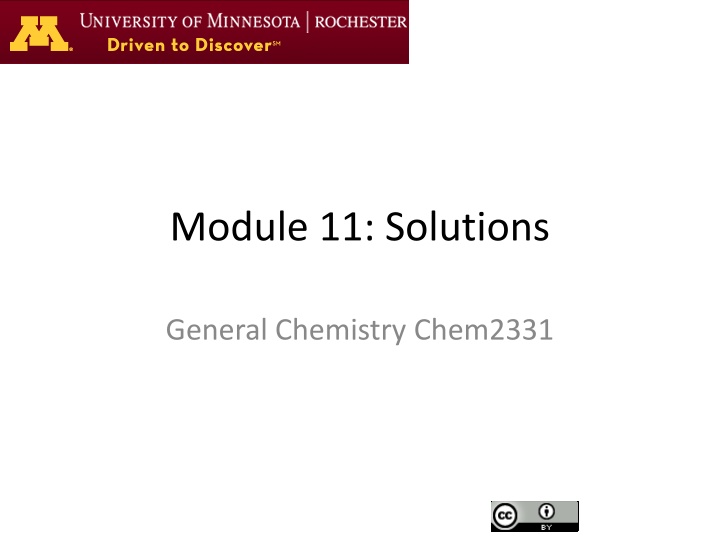
Concentration Calculations in General Chemistry
Explore different units of concentration, such as molarity and weight percent, and learn how to calculate concentrations of solutions in chemistry labs. Understand concepts like parts per million and billion and work on problems involving solute mass calculations in various solutions.
Download Presentation

Please find below an Image/Link to download the presentation.
The content on the website is provided AS IS for your information and personal use only. It may not be sold, licensed, or shared on other websites without obtaining consent from the author. If you encounter any issues during the download, it is possible that the publisher has removed the file from their server.
You are allowed to download the files provided on this website for personal or commercial use, subject to the condition that they are used lawfully. All files are the property of their respective owners.
The content on the website is provided AS IS for your information and personal use only. It may not be sold, licensed, or shared on other websites without obtaining consent from the author.
E N D
Presentation Transcript
Module 11: Solutions General Chemistry Chem2331
Module 10 Module 10 Session 2 1. Units of concentration 2. Weight percent units 3. Molarity 1. Definition of molarity 2. Converting among units 3. Concentration of electrolytes 4. Preparation of solutions from solids 5. Preparation of solutions form dilution 6. Osmolarity Chem 2331: General Chemistry 2
Units of concentration. The most common unit of concentration is mol/L Not to be confused by density (gram/L) C A Rank the solutions in order of increasing concentration B D E F Chem 2331: General Chemistry 3
Units of concentration Table 13.5 Concentration Definitions Concentration Term Ratio amount (mol) of solute volume (L) of solution Molarity (M) amount (mol) of solute mass (kg) of solvent Molality (m) Does not depend on Temperature mass of solute mass of solution Parts by mass volume of solute volume of solution Parts by volume amount (mol) of solute Mole fraction ( ) amount (mol) of solute + amount (mol) of solvent Chem 2331: General Chemistry 4
Units of concentration: weight percent units The maximum concentration of arsenic in drinking water that is allowed by the EPA is 0.050 mg/L. Express this as a weight percent. (You can assume the density of the water solution is 1.0g/mL.) The weight percent is mass_solute mass_solution 100% Parts per million (ppm) mass_solute mass_solution 106 Suppose a 155.3 g sample of pond water is found to have 1.7x10-4 g of phosphates. What is the concentration of phosphates in ppm? Parts per billion (ppb) mass_solute mass_solution 109 Chem 2331: General Chemistry 5
Units of concentration: Molarity You have 350.0mL of 0.200M aqueous KClO4. Which of the following statements are true? Choose at least one answer. a. For every liter of solution, there is 0.200 moles of KClO4. b. Water is the solvent. c. For every 0.200 liters of solution, there is 1 mole of KClO4. d. If you add KClO4 to the solution, the molarity will decrease. e. There is 350.0 mL of solvent f. There will be 0.200M of K+ ions Chem 2331: General Chemistry 6
Units of concentration: Molarity What is the mass of the solute in 1.5L of 3.55M calcium hydroxide? Chem 2331: General Chemistry 7
Converting units of concentration Convert 330 ppm solution of Pb(2+) into molarity and molality. Chem 2331: General Chemistry 8
Molarity: electrolytes Which of the following solutions has the greatest concentration of ClO3- ions? Choose one answer. a. 0.024M Al(ClO3)3 b. 0.077M LiClO3 c. 0.032M Ca(ClO3)2 d. 0.069M NH4ClO3 Chem 2331: General Chemistry 9
Preparation of solutions from solids. You need to prepare 100 mL solution of NaCl 0.1M. How much mass of NaCl do you need to dissolve? Chem 2331: General Chemistry 10
Preparation of solution with dilution. You need to prepare 250mL 0.2M of HNO3 from a more concentrated solution 5M HNO3. Explain the process and calculate the necessary quantities. Chem 2331: General Chemistry 11
Other units of concentration Other Units of concentration Using prefixes such as: mM: milimolar (10-3 mol/L) M: micromolar (10-6 mol/L) nM: nanomolar (10-9 mol/L) Example: For the analysis of trace metals it is necessary to prepare solutions of very low concentrations from a stock solution of higher concentration using a micropipette and a volumetric flask. What volume of a 0.0020 M solution of CuCl2(aq) would be required to prepare a 13 nM solution of Cu2+ in a 650 mL flask? Chem 2331: General Chemistry 12
Units of concentration: osmolarity and osmolality Osmolarity and osmolality For osmotic pressure and colligative properties what counts is the number of ions in solution. In medicine you will see the term Osmolarity and Osmolality: NaCl Na+ + Cl- 1 molar of NaCl is 2 osmolar MgCl2 Mg2+ + 2Cl- 1 molar of NaCl is 3 osmolar Al2(SO4)3 2Al3+ + 3SO42- 1 molar of Al2(SO4)3 is 5 osmolar Chem 2331: General Chemistry 13
Units of concentration Examples in medicine Normal saline (NS) is the commonly-used term for a solution of 0.90% w/v of NaCl, about 300 mOsm/L. for patients who cannot take fluids orally and have developed or are in danger of developing dehydration or hypovolemia. The solution is 9 grams of sodium chloride (NaCl) dissolved in 991 milliliter of water. http://en.wikipedia.org/wiki/Saline_%28medicine%29 Chem 2331: General Chemistry 14
A typical concentration problem You are given a water sample to analyze from a lake contaminated with lead. It takes 18 mL of 0.010 M NaCl to exactly precipitate the Pb2+ ions from 88 mL of the water sample. What is the concentration of Pb2+ ions in the water? Pb2+(aq) + 2NaCl(aq) PbCl2(s) + 2Na+(aq) Chem 2331: General Chemistry 15






















